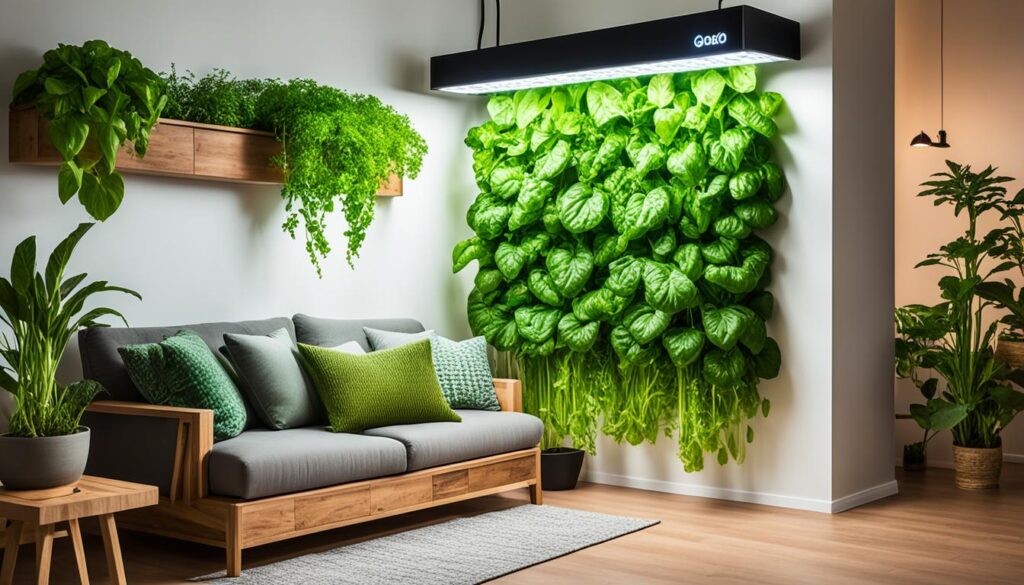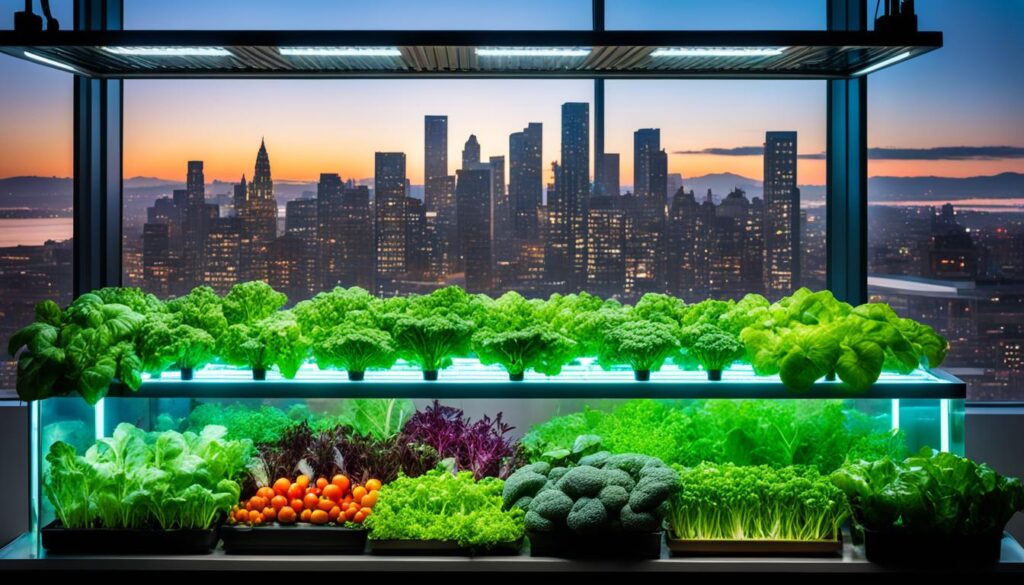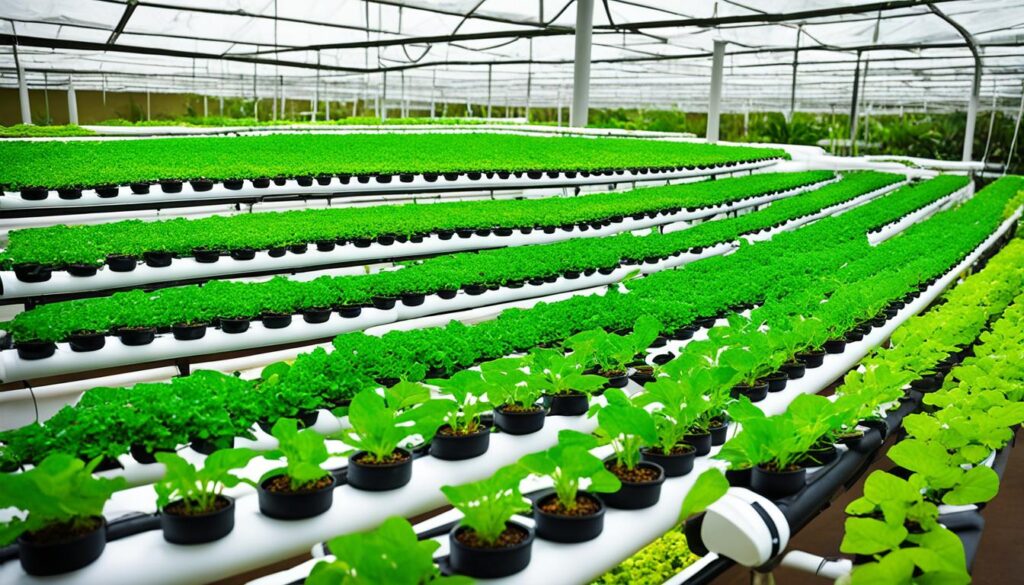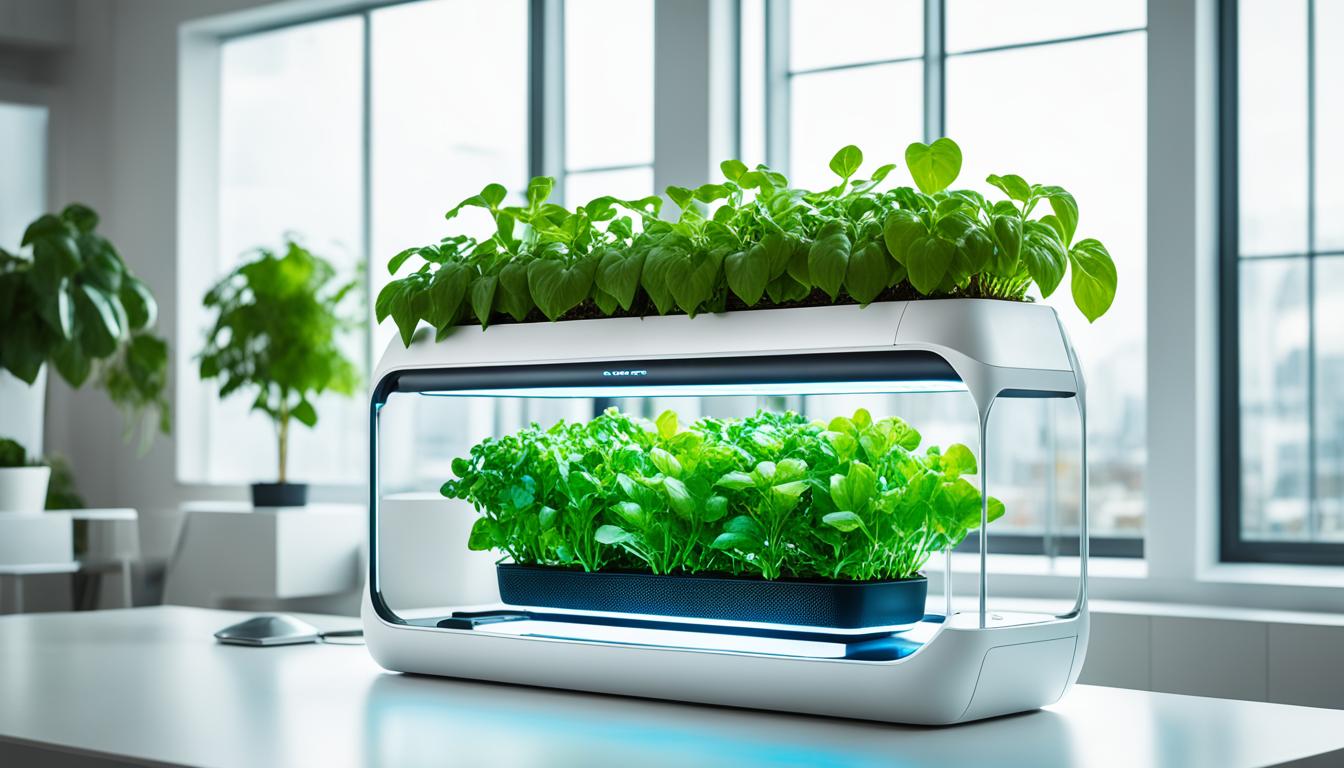As an urban dweller, I have always wanted to grow my own fresh vegetables but limited space and lack of gardening knowledge seemed like major obstacles. That was until I discovered the fascinating world of hydroponics. With hydroponic gardening, I realized that I could grow veggies without soil, right in the comfort of my own home!
Hydroponics is a soilless and efficient method of cultivation that is perfect for urban dwellers like me. It offers numerous advantages, allowing you to enjoy fresh, nutritious produce all year round. Plus, by eliminating the need for soil, hydroponics optimizes space utilization, making it ideal for those of us with limited gardening areas.
In this article, we’ll dive into the world of hydroponics and explore its benefits. We’ll also look at some beginner-friendly options for hydroponic vegetables and even highlight a selection of Indian vegetables that thrive in hydroponic systems.
Key Takeaways:
- Hydroponics is a soilless method of gardening that allows you to grow fresh vegetables at home without the need for traditional soil-based cultivation.
- Urban dwellers can benefit from hydroponics as it optimizes space utilization and enables year-round vegetable cultivation.
- Hydroponics offers advantages such as water efficiency, faster growth, controlled nutrient delivery, and the absence of soil-borne diseases.
- Beginners can start with hydroponic vegetables like lettuce, herbs, spinach, Swiss chard, green beans, and radishes.
- Indian vegetable lovers can also enjoy hydroponics with flavorful options like coriander, mint, fenugreek, spinach (palak), green chilies, and bitter gourd (karela).
The Benefits of Hydroponic Vegetables
Embracing hydroponic vegetables comes with a host of advantages. These include:
- Year-Round Cultivation: With hydroponics, you can grow vegetables throughout the year, regardless of the season or climate. This allows for a consistent supply of fresh produce and eliminates the limitations imposed by traditional outdoor gardening.
- Space Optimization: Hydroponic systems are designed to maximize space utilization, making them ideal for urban dwellers with limited gardening areas. Vertical setups and compact designs enable you to grow a large quantity of vegetables in a small area.
- Water Efficiency: Hydroponics uses a recirculating system that conserves water compared to traditional soil-based farming. The water is carefully monitored and delivered directly to the plants’ root systems, ensuring minimal waste.
- Faster Growth and Higher Yields: Hydroponic vegetables grow up to 30% faster than plants grown in soil. The controlled environment allows for optimal growth conditions, resulting in higher yields and more abundant harvests.
- Controlled Nutrient Delivery: With hydroponics, you have precise control over the nutrient composition delivered to the plants. This enables you to tailor the nutrient solution according to specific plant requirements, ensuring optimal growth and development.
- No Soil-Borne Diseases: Since hydroponic systems don’t use soil, the risk of soil-borne diseases is eliminated. This reduces the need for pesticides and fungicides, resulting in healthier, more natural vegetables.
- Year-Round Freshness: Hydroponically grown vegetables are harvested at their peak freshness, offering superior taste, nutritional value, and texture. With a continuous supply of fresh produce, you can enjoy garden-fresh meals throughout the year.
Hydroponic Vegetables for Beginners
If you’re new to hydroponic gardening, starting with beginner-friendly vegetables is recommended. Lettuce, herbs like basil and mint, spinach, Swiss chard, green beans, and radishes are all excellent choices for beginners.
Growing hydroponic vegetables is an exciting and rewarding experience. With the right knowledge and selection of vegetables, beginners can easily succeed in their hydroponic adventures. These beginner-friendly vegetables not only adapt well to hydroponic systems but also require simple care and maintenance.
Let’s take a closer look at these beginner-friendly hydroponic vegetables:
Lettuce
Lettuce is a versatile and popular choice for hydroponic cultivation. Its quick growth and shallow root system make it well-suited for various hydroponic systems. From crisp romaine lettuce to vibrant butterhead varieties, there are plenty of options to choose from.
Herbs
Herbs like basil and mint thrive in hydroponic setups, offering a fresh and aromatic addition to your indoor garden. These flavorful herbs can be used in a variety of culinary delights, ensuring a constant supply of fragrant, homegrown goodness.
Spinach
Spinach, known for its incredible nutritional value, is an ideal choice for hydroponic beginners. Its compact size and fast growth make it a perfect fit for limited spaces. Enjoy fresh, vitamin-rich spinach leaves harvested right from your indoor garden.
Swiss Chard
Swiss chard is not only visually stunning with its vibrant stems and large leaves but also a great hydroponic vegetable for beginners. Its ability to tolerate different growing conditions and high nutrient demands make it a resilient choice.
Green Beans
Green beans are not just for traditional soil-based gardens. These legumes are well-suited for hydroponics, providing a bountiful harvest of crunchy, flavorful pods. Enjoy the satisfaction of growing your own green beans year-round.
Radishes
Radishes are fast-growing vegetables that offer a refreshing crunch and a touch of spiciness. These root vegetables are tolerant of various hydroponic systems and can be harvested within a few weeks, providing a quick reward for beginner hydroponic gardeners.
| Vegetable | Advantages for Beginners |
|---|---|
| Lettuce | Quick growth, shallow roots, various varieties |
| Herbs (Basil, Mint) | Simple care, versatile culinary use |
| Spinach | High nutritional value, compact size, fast growth |
| Swiss Chard | Tolerant to different conditions, resilience |
| Green Beans | Bountiful harvest, year-round cultivation |
| Radishes | Fast-growing, crunchy, quick reward |
These hydroponic vegetables are just the beginning of your journey into the world of soilless gardening. Experiment, learn, and discover the joy of growing your own fresh and nutritious produce.
Indian Vegetables to Grow Hydroponically
If you’re a fan of Indian cuisine and want to grow your own vegetables using hydroponics, there are several delicious options to consider!
First on the list is coriander. This aromatic herb is a staple in Indian cooking and grows beautifully in a hydroponic system. Its refreshing flavor and versatility make it a must-have in any Indian herb garden.
Mint is another fantastic option. From chutneys to teas, mint adds a burst of freshness to many Indian dishes. Growing mint hydroponically ensures a steady supply of this fragrant herb throughout the year.
If you enjoy the unique taste of fenugreek, why not try growing it hydroponically? Fenugreek leaves, also known as methi, are commonly used in Indian curries and spice blends. By growing fenugreek in a hydroponic system, you can easily incorporate its distinct flavor into your culinary creations.
Spinach, or palak, is a nutrient-packed vegetable that thrives in hydroponic setups. Its vibrant green leaves and tender texture make it a popular addition to Indian curries, stir-fries, and salads.
For spice lovers, green chilies are a must-grow hydroponic vegetable. With their fiery kick, green chilies add heat and flavor to a wide range of Indian dishes. Growing them hydroponically ensures a consistent supply of fresh, hot peppers.
Last but not least, we have bitter gourd, also known as karela. This unique vegetable is a staple in Indian cuisine, valued for its health benefits and distinctive bitter taste. By growing bitter gourd hydroponically, you can enjoy its unique flavor all year round.
By incorporating these Indian vegetables into your hydroponic garden, you can savor the flavors of traditional Indian dishes while reaping the benefits of homegrown, pesticide-free produce.
| Indian Vegetables to Grow Hydroponically | Growing Conditions | Popular Uses |
|---|---|---|
| Coriander | Temperature: 65-75°F (18-24°C) | pH: 5.5-6.5 | Chutneys, curries, garnishes |
| Mint | Temperature: 70-85°F (21-29°C) | pH: 5.5-7.0 | Chutneys, teas, desserts |
| Fenugreek | Temperature: 60-80°F (16-27°C) | pH: 6.0-6.5 | Curries, spice blends, salads |
| Spinach (Palak) | Temperature: 60-75°F (16-24°C) | pH: 6.0-7.0 | Curries, stir-fries, salads |
| Green Chilies | Temperature: 70-90°F (21-32°C) | pH: 6.0-7.0 | Curries, chutneys, pickles |
| Bitter Gourd (Karela) | Temperature: 70-85°F (21-29°C) | pH: 6.0-6.5 | Curries, stir-fries, stuffed dishes |
With these flavorful Indian vegetables thriving in your hydroponic system, you can elevate your culinary creations with homegrown goodness.
Setting Up Your Hydroponic System
When diving into hydroponics, it’s essential to begin by setting up your hydroponic system properly. Following a few key steps will ensure a successful and thriving garden. Here’s what you need to do:
Select the Hydroponic System
The first step is to choose the right hydroponic system for your needs. There are various types available, including nutrient film technique (NFT), deep water culture (DWC), and ebb and flow systems. Consider factors such as space availability, budget, and personal preference when making your selection.
Select the Growing Media
The next step is to choose the growing media that will support your plants. Some common options include rockwool, perlite, vermiculite, and coco coir. Each has unique properties and benefits, so research and experiment to find the one that works best for you.
Prepare the Nutrient Solution
A vital aspect of hydroponics is providing the plants with the necessary nutrients. Prepare a nutrient solution according to the specific requirements of your chosen plants. Ensure the solution is well-balanced and provides all the essential elements needed for healthy growth.
Begin Planting
Once your hydroponic system is set up and the nutrient solution is ready, it’s time to begin planting. Follow the instructions for each plant, including proper spacing and planting depth. Gently place the seedlings or seeds into the growing media and secure them in place.
Maintain Optimal Conditions
To ensure the success of your hydroponic system, it is crucial to maintain optimal conditions for your plants. This includes providing adequate lighting, controlling temperature and humidity levels, and ensuring proper air circulation. Regularly check and adjust these factors as needed to create an ideal environment for your plants to thrive.
Monitor and Adjust
Continuously monitor your hydroponic system and plants for any signs of imbalances or nutrient deficiencies. Regularly check pH levels, nutrient concentrations, and overall plant health. Make adjustments to the nutrient solution and system parameters as necessary to keep your plants healthy and productive.
By following these steps, you’ll be well on your way to setting up a successful hydroponic system. Remember to select the right hydroponic system and growing media, prepare a balanced nutrient solution, and provide optimal conditions for your plants to thrive. With regular monitoring and adjustments, your hydroponic garden will yield fresh and healthy produce year-round.
Cultivating Abundance with Hydroponic Vegetables
Growing hydroponic vegetables offers a world of possibilities, allowing you to enjoy fresh and nutritious produce year-round. With hydroponic gardening, you can cultivate an abundance of vegetables without the need for soil, making it an ideal option for urban dwellers.
The benefits of hydroponic gardening are numerous. Firstly, hydroponics allows for optimized water usage, utilizing a recirculating system that conserves water compared to traditional soil-based gardening. This water-efficient approach is especially important in water-scarce regions.
Another advantage is that hydroponic systems enable year-round cultivation, regardless of the outside climate. You are no longer limited by seasonality and can have a constant supply of fresh produce at your fingertips.
Hydroponics also offers beginner-friendly options, making it accessible to those who are new to gardening. Lettuce, herbs like basil and mint, spinach, Swiss chard, green beans, and radishes are all excellent choices for beginners, as they are relatively easy to grow in hydroponic systems.
Indian Vegetables for Hydroponics:
If you’re fond of Indian cuisine, you’ll be glad to know that several Indian vegetables are well-suited for hydroponic gardening. Here are a few flavorful options to consider:
- Coriander
- Mint
- Fenugreek
- Spinach (Palak)
- Green Chilies
- Bitter Gourd (Karela)
By growing these Indian vegetables hydroponically, you can add a touch of authenticity to your meals while reaping the benefits of hydroponic gardening.
Hydroponic gardening not only allows for sustainable food production but also offers the opportunity to reconnect with nature, even in an urban setting. With a hydroponic system, you can create your own personal oasis and harvest fresh, flavorful vegetables right from your home.
If you’re ready to embark on your hydroponic gardening journey, the next section will guide you through the process of setting up your hydroponic system. From selecting the right system and growing media to preparing the nutrient solution and maintaining optimal conditions, you’ll learn everything you need to know to successfully cultivate an abundance of hydroponic vegetables.
Indoor Hydroponic Farming at Home in India
Indoor hydroponic farming has revolutionized the way we grow fresh and sustainable produce right at home in India. With this revolutionary solution, you can cultivate pesticide-free vegetables and herbs in an efficient and eco-friendly manner.
Indoor hydroponic farming offers a multitude of benefits. Firstly, it allows you to grow fresh produce year-round, regardless of weather conditions or limited outdoor space. By eliminating the need for soil, this method optimizes water usage and reduces the risk of soil-borne diseases. As a result, you can enjoy faster growth and higher yields compared to traditional gardening methods.
Another advantage of indoor hydroponic farming is the ability to provide precise and controlled nutrient delivery to your plants. This ensures that they receive the necessary nutrients for healthy growth, leading to bountiful and nutritious harvests.
Setting up your indoor hydroponic garden is easier than you might think. To begin, select the right hydroponic system that suits your space and needs. Choose from popular options such as deep water culture, nutrient film technique, or vertical systems.
Next, select the appropriate growing media, such as clay pebbles or coconut coir, to support the plant roots and retain moisture. Prepare the nutrient solution using specially formulated hydroponic nutrients, which can be easily purchased online or at gardening stores.
When it comes to choosing which crops to cultivate, consider starting with beginner-friendly options like lettuce, herbs, or leafy greens. These plants are relatively easy to grow and adapt well to hydroponic systems.
Adequate lighting is crucial for indoor hydroponic gardens, especially since natural sunlight may be limited. Supplemental grow lights, such as LED or fluorescent lights, help provide the necessary light spectrum for photosynthesis. Ensure your plants receive at least 12-16 hours of light per day for optimal growth.
Regular monitoring of pH and EC (electrical conductivity) levels is essential to maintain the ideal growing conditions for your plants. This ensures they receive the correct balance of nutrients and prevents any imbalances that could hinder their growth.
By embracing indoor hydroponic farming, you can enjoy the satisfaction of growing your own fresh and sustainable produce right at home. Whether you live in a bustling city or a small apartment, indoor hydroponics offers a convenient and eco-friendly way to nurture your green thumb while reaping the benefits of homegrown goodness.

Understanding Indoor Hydroponic Farming
Indoor hydroponic farming offers a unique approach to cultivating plants without the use of soil. Instead, this method relies on soil-less cultivation techniques, such as the use of substrates like perlite or coconut coir. By eliminating soil from the equation, indoor hydroponic farming optimizes water usage, resulting in efficient water conservation. This approach is especially beneficial for urban dwellers or those with limited outdoor space, as it allows for year-round cultivation regardless of weather conditions.
One of the major advantages of indoor hydroponic farming is the ability to produce pesticide-free and high-quality produce. Without the use of soil, the risk of soil-borne pests and diseases is minimized, reducing the need for harmful pesticides. Additionally, the controlled nutrient delivery system in hydroponics ensures that plants receive the perfect balance of essential nutrients, resulting in faster growth and healthier crops.
Through indoor hydroponic farming, urban gardeners can enjoy a sustainable and eco-friendly way of growing their own fresh produce. By eliminating the need for traditional soil-based farming, indoor hydroponics reduces the environmental impact associated with agricultural practices. Moreover, the ability to grow a wide variety of crops indoors opens up possibilities for culinary exploration and access to fresh, nutrient-rich ingredients year-round.
| Key Benefits of Indoor Hydroponic Farming |
|---|
| Soil-less cultivation |
| Optimized water usage and conservation |
| Year-round cultivation regardless of weather conditions |
| Production of pesticide-free and high-quality produce |
| Faster growth and healthier crops due to controlled nutrient delivery |
| Sustainable and eco-friendly farming method |
Advantages of Indoor Hydroponic Farming
Indoor hydroponic farming offers several advantages over traditional soil-based farming. Let’s take a closer look at the key benefits of this innovative cultivation method:
1. Space Efficiency
One of the significant advantages of indoor hydroponic farming is its space-efficient nature. Unlike traditional farming methods that require vast land areas, hydroponics allows you to grow plants vertically, utilizing space more effectively. With vertical growing systems and stacking techniques, you can maximize your yield even in limited spaces, making it ideal for urban gardening.
2. Water Conservation
Indoor hydroponic farming is known for its water efficiency. By utilizing recirculating systems and precise watering techniques, hydroponics conserves water compared to traditional soil-based farming. This is especially important in regions where water scarcity is a concern. With hydroponics, you can grow more plants using less water, making it an environmentally friendly choice.
3. Year-Round Cultivation
Thanks to controlled environments, indoor hydroponics enables year-round cultivation regardless of external weather conditions. By providing artificial light, temperature control, and optimizing nutrient delivery, you can create ideal growing conditions for your plants. This means you can enjoy a continuous supply of fresh produce without relying on seasonal changes.
4. Pesticide-Free Produce
Indoor hydroponic farming eliminates the need for pesticides. By removing soil and its associated pest populations, you can significantly reduce or eliminate pesticide usage. This leads to cleaner and healthier produce, free from harmful chemicals. With hydroponics, you can enjoy pesticide-free vegetables that are safe for you and your family.
5. Faster Growth
Hydroponics promotes faster plant growth compared to traditional farming methods. By providing plants with an optimized nutrient solution and ideal growing conditions, hydroponics accelerates growth rates. This means you can enjoy a quicker harvest and higher yields within a shorter time frame, making it a time-efficient cultivation method.

By harnessing the advantages of indoor hydroponic farming, you can grow your own fresh and sustainable produce, even in limited spaces. With space efficiency, water conservation, year-round cultivation, pesticide-free produce, and faster growth, hydroponics offers a promising solution for urban dwellers.
Setting Up Your Indoor Hydroponic Garden
When it comes to setting up your indoor hydroponic garden, there are a few key steps you’ll need to take to ensure successful plant growth and a bountiful harvest. Let’s dive into the details!
Choose the Right System
The first step is to select the right hydroponic system for your indoor garden. There are various options available, including deep water culture, nutrient film technique, and ebb and flow systems. Consider factors such as space availability, plant type, and personal preferences to make an informed decision.
Select Suitable Crops
Next, choose crops that are well-suited for indoor hydroponic gardening. Leafy greens like lettuce and herbs like basil are popular choices due to their relatively fast growth and compact size. However, don’t be afraid to experiment with other crops like tomatoes or peppers if you have enough space and appropriate lighting.
Provide Adequate Lighting
Proper lighting is crucial for indoor hydroponic gardens as it serves as a substitute for natural sunlight. LED grow lights are an excellent option as they provide the full spectrum of light required for plant growth. Position the lights at the correct distance and duration to ensure optimal light exposure for your plants.
Prepare the Nutrient Solution
In hydroponic gardening, plants derive nutrients from a liquid solution rather than soil. Prepare a nutrient solution that contains the essential minerals needed for healthy plant growth. You can either purchase pre-mixed nutrient solutions or create your own by following recommended ratios and formulas.
Monitor pH and EC Levels
Regularly monitor and maintain the pH and EC levels of your hydroponic system. pH levels affect nutrient availability, and EC (electrical conductivity) levels indicate the concentration of nutrients in the solution. Use pH and EC meters to monitor these levels and make any necessary adjustments to ensure optimal nutrient uptake by your plants.
By following these steps, you’ll be well on your way to setting up a successful indoor hydroponic garden. Remember to choose the right system, select suitable crops, provide adequate lighting, prepare the nutrient solution, and monitor pH and EC levels for optimal plant growth. Happy gardening!
Small-Scale Hydroponics: A Quick Guide
Small-scale hydroponics is the perfect solution for urban dwellers with limited space who still want to enjoy the benefits of growing their own fresh produce. In this section, I will provide you with a quick guide on what you need to get started with small-scale hydroponics, as well as the various benefits it offers, different types of hydroponic systems, support structures for your plants, and lighting options to consider.
What You Need
To begin your small-scale hydroponic journey, you will need a few essential items:
- A suitable space: Find a well-lit area in your home or apartment where you can set up your hydroponic system.
- A hydroponic system: Choose a system based on your available space, budget, and the types of plants you want to grow. Some popular options include the nutrient film technique (NFT), deep water culture (DWC), and ebb and flow systems.
- Growing media: Depending on your chosen system, you will need a growing medium such as perlite, vermiculite, or coconut coir to support the plants.
- A nutrient solution: Hydroponic plants rely on a nutrient-rich solution instead of soil to grow. Purchase a hydroponic fertilizer specifically formulated for the plants you intend to grow.
Planting containers: Select containers that are suitable for your chosen hydroponic system. Consider factors such as size, material, and ease of cleaning.
Benefits of Small-Scale Hydroponics
Small-scale hydroponics offers several benefits that make it an attractive option for urban gardeners:
- Space efficiency: Hydroponic systems require less space compared to traditional soil-based gardening, making them ideal for urban environments.
- Water conservation: Hydroponics uses up to 90% less water compared to conventional soil-based gardening, making it a more sustainable option.
- Year-round cultivation: With hydroponics, you can grow plants regardless of the season, allowing for a constant supply of fresh produce.
- Pesticide-free produce: By controlling the nutrient solution and environment, you can eliminate the need for harsh pesticides and chemicals.
- Faster growth: Hydroponic plants often grow faster and produce higher yields compared to their soil-grown counterparts.
Types of Hydroponic Systems
There are several types of hydroponic systems to choose from, each with its own advantages and considerations. Here are a few popular options:
| Nutrient Film Technique (NFT) | Deep Water Culture (DWC) | Ebb and Flow |
|---|---|---|
| Plants grow in a shallow nutrient-filled stream, with the excess solution returning to the reservoir. | Plants are suspended in a nutrient-rich solution, with the roots immersed in water. | Plants are periodically flooded with a nutrient solution and then drained to allow for oxygen absorption. |
 |
 |
 |
Support Structure for Plants
In a hydroponic system, plants require support to grow upright and avoid flopping over. Here are a few support structures commonly used in small-scale hydroponics:
“Trellis netting provides a vertical support system for vining plants like tomatoes, cucumbers, and beans. Alternatively, you can use stakes or cages to support individual plants.”
Lighting Options
Good lighting is crucial for the successful growth of hydroponic plants, especially when growing indoors. Here are some common lighting options:
- Fluorescent lights: Affordable and suitable for seedlings and leafy greens.
- LED lights: Energy-efficient and versatile, offering a full spectrum of light for all stages of plant growth.
- High-pressure sodium (HPS) lights: Ideal for flowering and fruiting plants, providing ample brightness and warmth.
Now that you have a quick guide on small-scale hydroponics, you’re ready to embark on your homegrown gardening adventure. Get started and enjoy the benefits of fresh, pesticide-free produce all year round!
Conclusion
Hydroponics at home offers a sustainable solution for urban dwellers to cultivate fresh and nutritious produce. By embracing hydroponics, you can enjoy the benefits of hydroponic gardening and contribute to sustainable food production in your own space.
Whether you choose to grow hydroponic vegetables or set up an indoor hydroponic garden, the possibilities are endless. Hydroponics at home allows you to bypass the limitations of traditional soil-based gardening and optimize your growing conditions, resulting in healthier and more abundant crops.
With hydroponics, you can indulge in the joy of urban gardening, regardless of the space constraints you face. From growing leafy greens and herbs to cultivating Indian vegetables, hydroponics opens up a world of fresh and nutritious produce right at your fingertips.
In conclusion, hydroponics at home revolutionizes the way we approach urban gardening, offering a sustainable and efficient solution. So take the leap and embark on your hydroponic journey to enjoy the multitude of benefits, fresh and nutritious produce, and the satisfaction of growing your own food.
FAQ
What are the advantages of hydroponic gardening?
Hydroponic gardening offers year-round cultivation, space optimization for urban dwellers, water efficiency, faster growth and higher yields, controlled nutrient delivery, absence of soil-borne diseases, and year-round freshness.
What are some beginner-friendly hydroponic vegetables?
Lettuce, basil, mint, spinach, Swiss chard, green beans, and radishes are excellent choices for beginners in hydroponic gardening.
Which Indian vegetables can be grown in hydroponic systems?
Coriander, mint, fenugreek, spinach (palak), green chilies, and bitter gourd (karela) are flavorful Indian vegetables that thrive in hydroponic systems.
How do I set up a hydroponic system?
To set up a hydroponic system, you need to select the right system, choose the appropriate growing media, prepare the nutrient solution, start planting, maintain optimal conditions, and regularly monitor and adjust as needed.
What are the benefits of indoor hydroponic farming?
Indoor hydroponic farming offers space efficiency, water conservation, year-round cultivation, pesticide-free produce, and faster growth compared to traditional soil-based farming.
How do I set up an indoor hydroponic garden?
To set up an indoor hydroponic garden, you need to choose the right system, select suitable crops, provide adequate lighting, prepare the nutrient solution, and regularly monitor pH and EC levels for optimal plant growth.
What is small-scale hydroponics and what are its benefits?
Small-scale hydroponics is a space-efficient option that allows you to grow fresh and nutritious produce at home. It offers benefits such as reduced water usage, year-round cultivation, and the ability to control plant support structures and lighting options.

